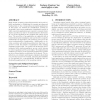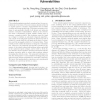10 search results - page 2 / 2 » Making Linux Protection Mechanisms Egalitarian with UserFS |
CODASPY
2012
12 years 19 days ago
2012
Main stream operating system kernels lack a strong and reliable mechanism for identifying the running processes and binding them to the corresponding executable applications. In t...
CCS
2004
ACM
13 years 10 months ago
2004
ACM
Address-space randomization is a technique used to fortify systems against bu
er over
ow attacks. The idea is to introduce arti
cial diversity by randomizing the memory location o...
ASPLOS
2009
ACM
14 years 5 months ago
2009
ACM
Software failures in server applications are a significant problem for preserving system availability. We present ASSURE, a system that introduces rescue points that recover softw...
ASPLOS
2009
ACM
14 years 5 months ago
2009
ACM
In a virtualized environment, device drivers are often run inside a virtual machine (VM) rather than in the hypervisor, for reasons of safety and reduction in software engineering...
CCS
2005
ACM
13 years 10 months ago
2005
ACM
Cyber attacks against networked computers have become relentless in recent years. The most common attack method is to exploit memory corruption vulnerabilities such as buffer ove...


